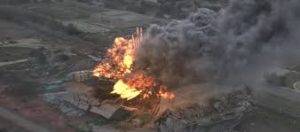Concerned About Another West, TX Chemical Facility Explosion? Tell EPA You Want Stronger Rules
By Carol Geiger
 Friday, May 13 Marks Deadline for comments to the proposed EPA Rules for Chemical Facilities such as the fertilizer plant involved in the West, Texas explosion.
Friday, May 13 Marks Deadline for comments to the proposed EPA Rules for Chemical Facilities such as the fertilizer plant involved in the West, Texas explosion.
The draft EPA Rule Fails in Protecting the Public as 87% of such Facilities Are Exempted by Federal Agency
Friday the 13th marks the deadline for the EPA’s proposed new rules on unique high risk chemical plants which are to urge the use and access to safer technologies to protect public health and welfare.
Public Citizen maintains that the new rules fall short of any real teeth to require industry to do what is needed, instead opting for too many voluntary measures of compliance to be protective of communities where these hazardous chemical facilities are sited.
“Though we commend the EPA’s attempt at new rules to rein in careless plant owners and operators,” commented Rita Beving, Public Citizen North Texas organizer, “These rules are simply weak, falling woefully short in the effort to protect the communities where these plants are located.”
“More than 87% of the facilities of the 12,543 facllities that should be regulated are exempt including water treatment facilities,” added Beving. “The way this rule is currently written still places cities such as DFW along with smaller communities which have such hazardous facilities at risk.”
The proposed rules entitled “Modernization of the Accidental Release Prevention Regulations under the Clean Air Act” were devised as a result of the deadly fertilizer plant explosion in West, Texas and other chemical plant disasters. Since West’s disaster in 2013, 82 people have been killed and 1,600 have been injured in more than 400 chemical plant incidents.
“There is still time to comment today and tomorrow on these proposed rules,” commented Tom “Smitty” Smith, Public Citizens Texas director. “We need to tell the EPA that too much of these new rules are voluntary. The rule fails to have the needed mandates that require industry to comply or improve the safety aspect of their operations.
“Instead of a patchwork of locations where these hazardous industries will be allowed to disclose their chemical information, there needs to be one singular database for emergency responders and officials to get the information they need in regards to these facilities,” added Smith. “This is just common sense safety for all our communities.”
According to facility reports to the EPA, over 100 million Americans still live in chemical hazard zones. In addition to putting facility employees at risk, communities closest to hazardous facilities are disproportionately African American and Hispanic.
Public Citizen asks that the EPA rule be strengthened by adopting the following measures within the new rules to protect public health and the communities in which they live:
- Require these unique hazardous facilities to use safer technologies and alternatives where they are feasible to prevent future disasters.
- Require all hazardous chemical facilities to conduct Safer Technology and Alternatives Analysis (STAA) – including water treatment facilities.
- The proposed rule now exempts 87% of the 12,543 (RMP) chemical facilities from requirements to conduct Safer Technology and Alternatives Analysis (STAA) including water treatment facilities, some of which put major cities at risk of a catastrophic release of chlorine gas. An Safer Technology and Alternatives Analysis shouldbe required of all facilities. An STAA involves reducing risks through a tiered approach of minimizing risk by reducing the amount of hazardous chemicals stored, employing physical barriers to mitigate hazard, utilizing emergency controls/sensors, and having safety and evacuation procedures in place. These plants’ STAA plans should also be accessible to the public.
- The proposed rule now exempts 87% of the 12,543 (RMP) chemical facilities from requirements to conduct Safer Technology and Alternatives Analysis (STAA) including water treatment facilities, putting major cities and other communities at risk of a catastrophic release of chlorine gas.
- The rule should require chemical facilities to report their Safer Technology and Alternatives Analysis to the EPA. These analyses should be accessible to the public.
- The EPA should establish an online clearinghouse of safer technology and available alternatives for these unique chemical facilities that would encourage and support plants’ adoption of safe technology alternatives.
- The EPA should devise a one stop, 24/7 accessible database of information via web requiring information about a chemical facility’s hazards that is accessible to public officials and emergency responders.
Currently, the proposed rule suggests using a patchwork of company web sites, libraries or government offices to disclose information on facility hazards to emergency planners and community residents. By not having these facilities utilize one accessible database of disclosure, companies can conceal the results of their assessments from local residents, schools, and hospitals near these facilities.
- Require buffer zones around existing facilities or restrictions on the location of new facilities in populated areas.
Comments are to be submitted online, identified by docket EPA-HQ-OEM-2015-0725 to the Federal eRulemaking Portal: http://www.regulations.gov or paste https://www.regulations.gov/#!documentDetail;D=EPA-HQ-OEM-2015-0725-0001 into your browser.
Below are examples of chemical incidents that led to the EPA rulemaking:
- April 17, 2013 – an explosion at the West Fertilizer facility in West, Texas killed 15 people.
- March 23, 2005 – explosions at the BP Refinery in Texas City, Texas, killed 15 people and injured more than 170 people.
- April 2, 2010 – an explosion and fire at the Tesoro Refinery in Anacortes, Washington, killed 7 people.
- August 6, 2012 – a fire at the Chevron Refinery in Richmond, California, involving flammable fluids endangered 19 Chevron employees and created a large plume of highly hazardous chemicals that traveled across the Richmond, California, area. Nearly 15,000 residents sought medical treatment due to the release.
- June 13, 2013 – a fire and explosion at Williams Olefins in Geismar, Louisiana, killed 2 people and injured more.